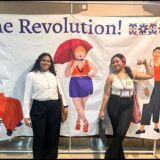Learning hands-on!
Day 2 of ASAP’s Safe Abortion Advocacy Institute #ASAPYAI for #YouthChampions had several hands-on learning activities for participants. Shreejana Bajracharya, our Youth Champion from Nepal led a session on understanding reproduction and contraception in the context of safe abortion. Participants played out different roles, including that of a sperm, IUD, ovum, condom , which led to much hilarity ! They enacted their roles within a large uterus drawn on the floor to and presented different scenarios including how fertilization takes place, how a condom works and how an IUD prevents fertilization. Instead of simply taking about fertilization and contraceptive methods, this demonstrated the science behind it in a fun and easy to remember way !
Papaya Workshop: Participants learned about manual vacuum aspiration and how to use an ultra sound machine using papayas as uterine models. Papaya workshops are fun, inexpensive, and easily replicable models to teach gynecologic, intrauterine procedures to lay persons. To know more about Papaya Workshops, click here.
The papaya workshop allowed participants to use technology and learn methods, related to #SafeAbortion, that are otherwise privy to health care professionals only — leaving the participants more empowered as a result.
Abortion laws in Asia
In order to help participants understand the variances in abortion laws across Asia-Pacific, they were divided into country-specific groups and asked to share any laws related to women’s rights and in specific rights to reproductive health and safe abortion from their own countries. Participants also shared about contraceptive access in their countries.
A participant from China talked about the one child policy and how this influences those accessing abortion. Another shared how contraceptive pills are very hard to purchase in Myanmar and how the government and police enforced a ban on emergency contraceptives during a national festival. A YAI alumni from the Philippines shared her experience running the ASK-MADS hotline and the backlash they receive for being RH activists, including being blogged about by pro-life activists. Participants from Bangladesh shared how they use Menstrual Regulation to circumvent anti-abortion laws and are able to provide services despite the restrictive in-country environment due to religious or cultural sentiments. A participant from Afghanistan shared how the country’s penal code penalizes the woman or health care provider monetarily (through fines) if they seek or provide abortions. It’s considered as a crime but is permitted only if the mother’s life is at risk.
The group then identified and discussed about traditional gatekeepers — such as partners, parents, health care providers — and how they influence those who access abortions as well as the implementation of laws. Gatekeepers interpret the law from their own biases and this restricts access to abortion services.
Click here to download Shilpa’s presentation on Abortion laws
Group Exercise
Participants were asked to play the role of decisions makers on abortion laws and had to choose or rank cases where they would grant or not grant women abortions. The discussion brought out personal biases, perspectives and showed how easily women’s rights could be reduced to ‘needs’ that others get to prioritize or decide on. Participants shared the process they went through to arrive at their choices and how these were colored by their own perspectives. “It felt powerful”, said one, “to make decisions for others”. The facilitator emphasized how important it is to give decision-making power back to women and let them decide.
Participants watched two videos made by ASAP Youth Champions from Sri Lanka and the Philippines on women’s experiences of having an abortion: It’s her Right – To Mr. President and Tainted
Both films depict how abortion stigma affects those seeking to terminate unwanted pregnancies; their health and dignity. The group shared how women who undergo abortions feel ‘guilty’ after the process on account of this stigma and attribute any misfortune that might follow the abortion to punishment by God. This highlights how religious sentiments promote abortion myths and have a psychological impact on women who’ve had or want to have abortions.
WHO GETS TO DECIDE? What it means to be pro-choice
Day 2 concluded with a thought provoking session on who makes decisions for #women that impact the amount of control they have over their own bodies? Are choices made in a vacuum? Or, are there external pressures that influence the choices a woman makes about terminating a pregnancy? Governments, for military and economic reasons, control population and dictate how many children a family should have.
“You stand by women’s right to make choices for themselves”, — -it has come down to the choice “to keep a pregnancy or not”
Participants discussed their own role as pro-choice activists and change agents who challenge the status quo/ norm. They learned about the ‘Advocacy cycle’: identify the problem, gather information, make a decision, plan, take action, evaluate. They also learned how to challenge the status quo by using ‘Subversion’ and turning issues upside down or looking at issues from a different angle.













